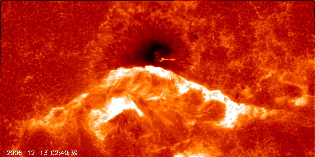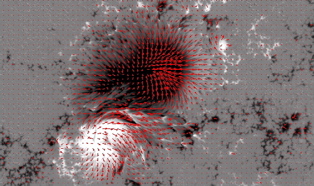Astronomers are calling the Japanese Hinode spacecraft a “Hubble for the sun.” Watch this movie and you’ll see why: The footage, gathered by Hinode’s Solar Optical Telescope (SOT) on Dec. 13, 2006, shows sunspot 930 unleashing a powerful X-class solar flare.

Click here
“Solar flares are essentially magnetic,” John Davis explains. In the maelstrom above a sunspot, lines of magnetic force are twisted and stretched until the tension reaches a certain point-and then the whole thing explodes.
Regard the animation below. It looks like a rampaging hurricane–about twice as wide as Earth! In fact, it is a magnetic map of the flare zone on the southern flanks of sunspot 930. Red arrows indicate the direction of the sunspot’s magnetic field. White areas have positive polarity (N); black areas are negative (S).

Click here
On Dec. 13, 2006, at precisely 0234 UT, the energy was released in the form of an X3-category solar flare. The explosion hurled a coronal mass ejection (CME: a billion-ton cloud of gas) into space, which sparked Northern Lights as far south as Arizona when it hit Earth a day later.















Runaway! Runaway!
Good thing the Earth has a magnetic field protecting it. What happens to Earth when we get hit by one of these CMEs when the magnetic poles are in the middle of a north/south switch?
Awesome stuff … also, really nice of you guys to put the videos in the enclosure tag. Made it very convenient to watch straight from the RSS reader.
That’s pretty neat – thanks for the video
Another great mission, the STEREO twin satellites homesite is here:
http://www.nasa.gov/mission_pages/stereo/main/index.html
Enjoy.
2. Your Blackberry would stop working?
2, Improbus, without Earth’s magnetic field, a CME would definitely be more dangerous. Adios, internet, power grid and aurorae. Interesting sites here:
http://www.spaceweather.com/
http://en.wikipedia.org/wiki/Aurora_(astronomy)#Auroral_mechanism
6, mark, any help you need with your scope or questions on astronomy or scopes, just ask anytime. Planning next fishin’ trip to VI. And, yes, goodbye CrackBerry, cellphones, etc. Landlines might still work.
Biggest in recent times produced a ground 1 minute mean flux density of around 4.5 mW/m2. The biggest historical CME in 1859 was so massive that they still find traces in Greenland ice. You wouldn’t want to be in a jet airplane when one, that big, hits. Even if the aircraft operated afterwards, the radiation dose would be something similar to having a few chest x-rays.